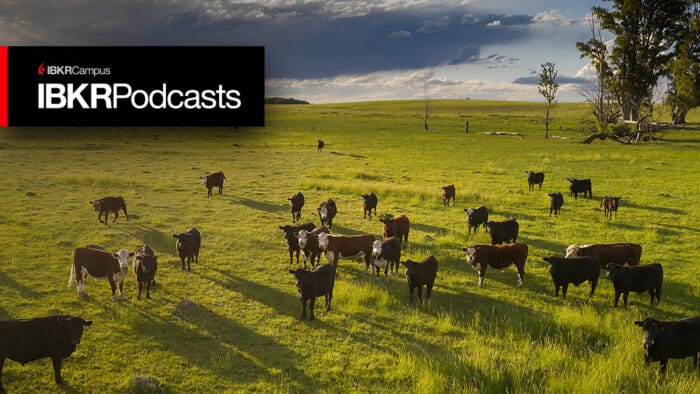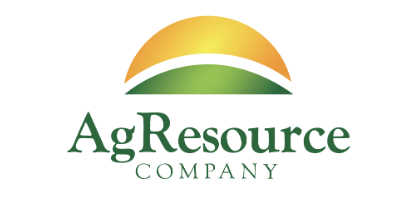Faced with escalating Chinese demand for Brazilian grains, US farmers are struggling with soggy prices for agricultural products. Dan Basse of AgResource explains why planting intentions for 2024 crops are lower this year.
Summary – IBKR Podcasts Ep. 154
The following is a summary of a live audio recording and may contain errors in spelling or grammar. Although IBKR has edited for clarity no material changes have been made.
Andrew Wilkinson
In today’s episode, I’ve recruited the services of Dan Basse in Chicago. Welcome, Dan.
Dan Basse
Oh, welcome, Andrew. Good to be with you again.
Andrew Wilkinson
It’s always good to talk. We’re going to be talking about crops today. Dan’s the President of AgResource Company, which specializes in monitoring agricultural crop progress. And you’re also a farmer, Dan.
Dan Basse
I am a farmer. I have a dairy cattle farm and a couple of crop farms. So I keep my fingers in the dirt and my tractor time is precious, so I enjoy going around in circles very much.
Andrew Wilkinson
Very good. So what’s really important here is what you go through in terms of monitoring agricultural crop progress, right? And that’s because the supply and demand for such commodities are the number one drivers of prices that those items end up costing us in the supermarket.
And we’re talking about things such as corn, soybeans and wheat, primarily, but importantly, the growers of those crops. So, Dan, tell us about the US planting season. How’s it going? And what are the weather challenges for US farmers right now?
Dan Basse
The planting season is well underway. We’ve got about 20% of our corn crop, maybe 12% of our soybean crop planted and we’re getting along with spring wheat. So those are the three principal crops. Of course, there’s always cotton and rice and a lot of ancillary crops, but the biggies, if you will, Andrew, are moving along nicely.
We’re a little concerned about the amount of rain that’s coming this weekend and next week. A lot of moisture. But some of it’s a mixed blessing because we suffered through a winter that was very warm and dry. You know, we look backwards in the window of weather, the winter of 2024 ended up being record warm.
And so with that warmth, we really didn’t get the snow cover and a lot of the moisture that would seep into the soil. And so that worried us heading into spring. But this rain will be helpful and we’ll see what Mother Nature throws at us then as we go into the June, July, August period really when crop yields are made and crops come to fruition.
Andrew Wilkinson
Let’s turn to grain prices, Dan. They’ve fallen to what? Three-year lows? How are US farmers doing and more importantly, well, I don’t know about more importantly, but how about farm income? How’s that going?
Dan Basse
It’s really a tough time. I know most of America is doing relatively well. But if I take you back a couple of years and we look at USDA projections, net farm income is down $67 billion. Now that’s about 31% from where we were back in 2022. So it’s the largest drop on record that’s projected for net farm income this year.
And so it is a tough time on the farm, you know? We had good prices that came out of the inflationary days on 2022 and as those prices rose, we had crop input, the people, whether it be a machinery maker or a seed seller or a fertilizer producer, they all had our hand in the farmer’s pocket because they wanted a share of that extra margin. And now, as prices have dropped over the last 18-20 months, largely due because rising rates, competition from South America and China being far less involved in terms of buying US agricultural goods.
Prices have come down and those hands haven’t come out of our pockets. And so we’re kind of in this vice right now where costs are high, prices are low. And our break evens this year are not going to be covered. And so unless there’s a weather rally as we get into this summer, it looks to be a fairly grim year for the US grain farmer.
Andrew Wilkinson
Well, let’s pick on one of those points you just made though, Dan, about China.
It’s been securing an increasing amount of grain and foods away from the United States. So why is that and how does it impact US farmers? I’d imagine not in a good way.
Dan Basse
No, no. In fact, China has been buying, Andrew, record amounts of corn and other grain products, but they’ve not been buying it from the US. Back in 2022, China decided to approve Brazilian corn production and their varieties as being importable. It’s a phytosanitary exercise. And so they did that. And this year, China is primarily importing corn from Brazil. Of the 20 million metric tons of corn that China has imported so far, only two have come from the United States.
And so, this a few years ago was just the opposite, where China was buying most of its grain from the United States, principally because of a phase one agreement done by the Trump Administration. That all changed, and now China, because of the political bashing that is going on between the United States and China, competitive bashing maybe is the way to say it, is now hurting our demand. China is our biggest customer in US agriculture, taking about $36 billion of agricultural food items every year. So, with China now principally looking at diversifying those suppliers because of economic and political concerns out of the US, it’s a problem for US farmers.
Andrew Wilkinson
And something else that we can’t control is the weather. And we’ve seen very strange, erratic world weather conditions. Maybe it is climate change, maybe it isn’t. But what’s the outlook for the 2024 US and Northern Hemisphere growing season? What does that look like now?
Dan Basse
Well, we’ve already got some issues, you know? Not only we have we had the problem with China, we’ve also had this war ongoing in the Black Sea with Russia and Ukraine battling it out.
Strangely, as Russia and Ukraine have been battling, they’ve been selling grain as cheaply as they can to get hard currency. So, although the grain flows out of the Black Sea are quite strong, it’s happening at a very cheap price and this is not helping US farmers also. As we look at world weather at the moment, we’re concerned about Russia and that’s why I highlighted that.
Because the Russians are starting to see some dryness in the portions of their winter wheat belt. Southwest Russia. Krasnodar, Stavropol and some of those areas are really starting to get dry now. So again, the month of May is the key time frame for winter wheat in Russia. The major producer, the major exporter in the world. Though we have issues in the United States, also. I mentioned about that very warm winter. Well almost on a one-to-one relationship when the United States and the central parts of the US has a warm winter, it also has a warm summer.
So we’re looking for heat to be a predominant feature this year. Where it exactly sets up, will it be dry is unknown, but that heat is something that crops and livestock don’t like, and so we’ll see how that impacts production and yield going forward.
Andrew Wilkinson
So Dan, let’s talk about planting intentions. Farmers have so far indicated to the USDA that they intend to plant 6.3 million acres less than last year. What’s going on there?
Dan Basse
Well, you can imagine that as we farmers are struggling economically, we’re looking at those fragile acres that may not be able to produce a crop in a normal year and we’re just not planning them. I mean, if you can’t make money, why would you go ahead and beat your head against the wall and put in seeds? So, whether it be what Texas, Kansas, Oklahoma, maybe the Dakotas. These are fragile lands, if you will, in the United States. And so farmers have just said enough. I’m not going to go forward and plant these acres.
We also have the USDA which is embarking on what I would say is a revitalization of a program. We in the United States set aside acres called Conservation Reserve acres. These are acres that are fragile. Farmers get paid for setting them aside as long as 10 years, and they’re done so that wildlife and environmental conditions can prevail in these counties and communities that have these lands along major flyways of waterfall and these kind of things.
So we’ve added a million and a half acres in the last year. And so when you think about the additionality of that program, along with the poor margins, it’s not surprising that US farmed acres come down. In fact, I can even envision that number getting close to 10 million acres as we turn to calendars to June. And we really look at what farmers will be producing.
Andrew Wilkinson
Dan, one thing that’s been front and center of my mind at home, I’ve got a large family, is the cost of food over the last 3-4 years.
I’m wondering whether my grocery bills are ever going to come back down, and I’m wondering also, given what you’re telling me about grain costs and prices that I should expect that at some point. But what are the risks going forward?
Dan Basse
I always tell everybody in the grocery store. First of all, prices have gone up. But when I look at the world globally, Americans only spend 6.9% of their disposable income on food. So, we’re the cheapest in the world. Not only are we the cheapest, but we have the biggest bounty and supply opportunity. So that’s a good thing.
But on the other side of it, no one wants to pay more. So that’s the other side of this. And we do understand that as farmers. Nonetheless, grain prices have come down. But I got to tell you, in every loaf of bread and everything that’s made from a processing standpoint, we farmers get about nine cents of every dollar.
So we’re not the people that are really looking at raising prices and doing everything else. Prices are low for principal grains and we would think that food prices would come down accordingly, but it’s the cost of labor. It’s the cost of transportation. It’s the cost of equipment. It’s the cost of inventory with rising interest rates. And so all of those kind of combined for food prices to be higher for longer.
And what I’m really a little concerned about is, is what I would call the protein side of our plates. The US cattle herd is at the lowest level looking backwards since 1969. But the beef cattle herd is even lower. So, it takes me about three years to get a cow bread and a baby calf and to get her onto your plate, if you will. If you want to think about it strangely that way.
So, the cycle is long, and I don’t see a chance to rebuild the protein side of your plate anytime soon. So, whether it be things like cattle or pork, prices are going to stay high. I don’t know what to make about this new avian flu in dairy herds. I’m a dairyman. So, we’re watching it carefully, but it will affect milk production and affected herds.
So you may see supplies of milk tighten and this may give us some increase in at least what you’re paying for milk and dairy products at the grocery store. But again, it’s early days and it’s this new novel disease and we really don’t know what to do with it, Andrew. But we’re watching it carefully and crossing our fingers anyway that consumers will continue to buy dairy foods because we pasteurize the milk and it is relatively safe.
Andrew Wilkinson
My guest today has been President at AgResource, Dan Basse. Thank you very much for joining me, Dan.
Dan Basse
You’re very welcome, Andrew. Always a pleasure.
Andrew Wilkinson
And please remember to rate our recent podcasts wherever you download your podcasts from and lookout for more episodes at IBKR podcasts.
Join The Conversation
If you have a general question, it may already be covered in our FAQs. If you have an account-specific question or concern, please reach out to Client Services.
Leave a Reply
Disclosure: Interactive Brokers
The analysis in this material is provided for information only and is not and should not be construed as an offer to sell or the solicitation of an offer to buy any security. To the extent that this material discusses general market activity, industry or sector trends or other broad-based economic or political conditions, it should not be construed as research or investment advice. To the extent that it includes references to specific securities, commodities, currencies, or other instruments, those references do not constitute a recommendation by IBKR to buy, sell or hold such investments. This material does not and is not intended to take into account the particular financial conditions, investment objectives or requirements of individual customers. Before acting on this material, you should consider whether it is suitable for your particular circumstances and, as necessary, seek professional advice.
The views and opinions expressed herein are those of the author and do not necessarily reflect the views of Interactive Brokers, its affiliates, or its employees.
Disclosure: Futures Trading
Futures are not suitable for all investors. The amount you may lose may be greater than your initial investment. Before trading futures, please read the CFTC Risk Disclosure. A copy and additional information are available at ibkr.com.



















Great interview. Would love to hear more from Dan! As an ag trader – this is fascinating stuff. Thank you.
Thanks for engaging!